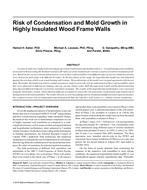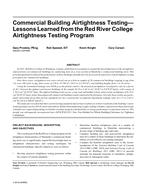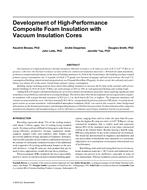-
-
Available Formats
- Options
- Availability
- Priced From ( in USD )
-
Available Formats
-
- Immediate download
- $15.00
- Add to Cart
Customers Who Bought This Also Bought
-

Risk of Condensation and Mold Growth in Highly Insulated ...
Priced From $16.00 -

Commercial Building Airtightness Testing--Lessons Learned...
Priced From $16.00 -

Development of High-Performance Composite Foam Insulation...
Priced From $16.00 -

Using the Thermal Mass of a Building to Reduce the Magnit...
Priced From $16.00
About This Item
Full Description
Reducing the energy demand of existing buildings is one of the main ways to achieve a strong decrease in CO2 emissions,as imposed by the EU. In Belgium, brick cavity walls are a widespread external wall type. Consequently, this offers a large potentialin energy savings by cavity wall insulation. However, to avoid and track execution flaws, it is recommended to assess the thermalperformance before and after the execution and to detect obstructions in the cavity (e.g., thermal bridges).
Infrared thermography offers a quick and nondestructive technique to fulfill the task. With an infrared camera, the surfacetemperature of a building component is instantly visualized, by which thermal bridges and execution flaws can be detected. Toassess the potential of thermography in the evaluation of cavity wall insulation, dynamic numerical simulations were executedon a brick wall with cavity insulation. One model contained an air inclusion in the cavity insulation; in the second model thevisibility of a thermal bridge was examined. Next to that, infrared inspections of over 30 in-situ cases were analyzed and comparedwith execution reports, flux measurements, and endoscopy inspections. The results show that thermal bridges and large insulationdefects are detectable when direct sun radiance is avoided during and a day prior to the survey. Additionally, attention shouldbe granted to the measurement distance and condition of the surface. The results have been converted into practical guidelinesfor the infrared inspection of filled cavity walls.
Citation: Thermal Performance of Exterior Envelopes of Whole Buildings XIII, Conference Papers





